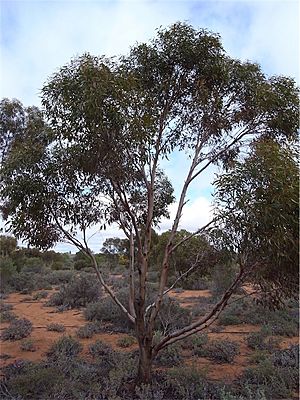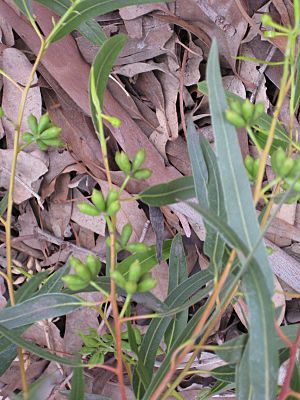Dundas blackbutt facts for kids
Quick facts for kids Dundas blackbutt |
|
|---|---|
 |
|
| Scientific classification | |
| Genus: |
Eucalyptus
|
| Species: |
dundasii
|
| Synonyms | |
|
Eucalyptus dundasi Maiden orth. var. |
|
The Dundas blackbutt (scientific name: Eucalyptus dundasii) is a special type of tree found only in Western Australia. It's known for its unique bark, which is rough and scaly at the bottom of the trunk. Higher up, the bark becomes smooth. This tree has long, narrow leaves, and its creamy white flowers grow in groups of seven. After flowering, it produces interesting cylindrical or urn-shaped fruits.
Contents
What the Dundas Blackbutt Looks Like
The Dundas blackbutt is a tree that usually grows to be about 5 m (16 ft) to 21 m (69 ft) tall. It has a special woody swelling at its base called a lignotuber. This helps the tree regrow if it gets damaged, for example, by fire.
Its bark is quite interesting. The lower part of the trunk has rough, scaly bark that can be grey-black, grey, or black. Higher up, the bark is smooth and often looks greyish with hints of copper.
Young plants and new shoots have wider, lance-shaped leaves. These leaves are usually 65 mm (2.6 in) to 110 mm (4.3 in) long and 30 mm (1.2 in) to 45 mm (1.8 in) wide. As the tree gets older, its leaves change. Adult leaves are glossy green on both sides. They are narrow and lance-shaped, about 60 mm (2.4 in) to 135 mm (5.3 in) long and 6 mm (0.24 in) to 17 mm (0.67 in) wide. Each leaf has a stalk called a petiole, which is about 8 mm (0.31 in) to 18 mm (0.71 in) long.
The tree's flower buds grow in groups of seven. They are found where the leaves meet the stem (called a leaf axil). These buds sit on a stalk called a peduncle, which is 6 mm (0.24 in) to 16 mm (0.63 in) long. Some buds sit directly on the stem without a small stalk (these are called sessile), while others have a very short stalk (a pedicel) up to 1 mm (0.039 in) long.
When the buds are ready to open, they look like small cylinders. They are about 7 mm (0.28 in) to 11 mm (0.43 in) long and 3 mm (0.12 in) to 4 mm (0.16 in) wide. Each bud has a beak-shaped cap called an operculum.
The Dundas blackbutt flowers between February and July. Its flowers are a lovely creamy white color. After the flowers, the tree produces woody fruits. These fruits are called capsules and are shaped like cylinders or urns. They are about 8 mm (0.31 in) to 9 mm (0.35 in) long and 4 mm (0.16 in) to 6 mm (0.24 in) wide. The parts that release the seeds are tucked inside the rim of the fruit.
How it Got its Name
The scientific name Eucalyptus dundasii was first officially described in 1916. This was done by a botanist named Joseph Maiden. He published his description in a science journal called the Journal and Proceedings of the Royal Society of New South Wales.
The very first sample of this tree, called the type specimen, was collected near a place called Dundas in 1901. This is why the tree's specific name (dundasii) refers to that location. Dundas was an old mining town.
Where the Dundas Blackbutt Lives
The Dundas blackbutt is found only in Western Australia. This means it is endemic to that area. It grows in flat areas and near salt lakes, often as part of open forests and woodlands.
You can find this tree in a wide area, from near Lake Barlee all the way to Salmon Gums and the Fraser Range. These areas are part of the Coolgardie, Mallee, and Murchison regions.
The Dundas blackbutt often grows with other types of eucalyptus trees. These include the York gum (E. loxophleba), Wandoo (E. wandoo), E. eremophila, Salmon gum (E. salmonophloia), Goldfields blackbutt (E. lesouefii), and Coral gum (E. torquata).
Below these taller trees, you might find smaller trees like Eucalyptus flocktoniae and other types of mallees (smaller, multi-stemmed eucalypts). The types of shrubs growing underneath depend on how salty the soil is. In less salty areas, you'll see many Acacia species. In more salty areas, Eremophila and Atriplex species are more common.
Is it Protected?
The Western Australian Government's Department of Parks and Wildlife has looked at the Dundas blackbutt. They have classified it as "not threatened." This means it is not currently at risk of disappearing.
Growing Dundas Blackbutt
This type of eucalyptus tree is popular for horticulture (gardening and landscaping). You can buy its seeds or young plants (called tube stock).
It's a tough tree that can handle salty soil, dry conditions (drought), and even frost. Because of this, it's often grown as a shade tree or a street tree in dry areas.


